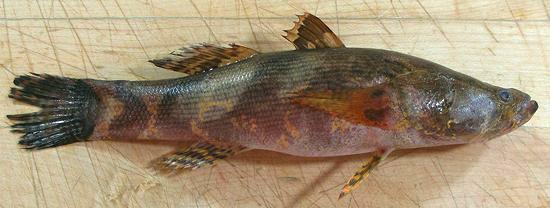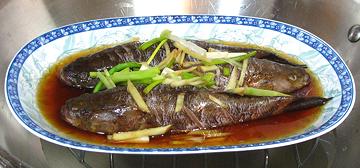Marble Goby
 [Marble Sleeper; Ca bong Tuong (Viet); Bia (Philippines); Pla bu sai,
Pla bu jak (Thailand); Soon Hock (Singapore); Ikan Bakut, Bakutut,
Kedebuk (Indonesia); Damrey (Cambodia); Pa Bou (Laos); Belatoc
(Malaysia); Kawaango (Japan); Oxyeleotris marmorata ]
[Marble Sleeper; Ca bong Tuong (Viet); Bia (Philippines); Pla bu sai,
Pla bu jak (Thailand); Soon Hock (Singapore); Ikan Bakut, Bakutut,
Kedebuk (Indonesia); Damrey (Cambodia); Pa Bou (Laos); Belatoc
(Malaysia); Kawaango (Japan); Oxyeleotris marmorata ]
This is the largest of the Gobies, reaching 26 inches, but most commonly
no more than 12 inches. It is widespread, found in fresh and brackish
waters throughout Southeast Asia, including Indonesia and the Philippines.
It is a very lazy ambush hunter, why it is called a "Sleeper" - it just
gulps down food that swims by its nose. It is much sought as an
outstanding eating fish, and is also popular in aquariums.
This fish is caught wild and farmed. It is a problem fish for
farming, as it insists on live food, but the demand is high, so it is
increasingly farmed. The photo specimen was 7-3/4 inches long, weighed
4-1/4 ounces, and was farm raised in Vietnam. This fish is IUCN Red
List rated LC (Least Concern).
More on Gobys.
 This fish is cooked, whole or head-off, by either steaming or
deep frying. The photo to the left shows 3 7-3/4 inch fish prepared for
steaming in accordance with our recipe
Steaming Fish Chinese
Style. This recipe works very well - but go easy on the soy
sauce so you don't mask the delicate taste of the flesh. Keep the
steaming time down to 9 minutes after covering for 7 inch fish,
a bit longer for larger fish.
This fish is cooked, whole or head-off, by either steaming or
deep frying. The photo to the left shows 3 7-3/4 inch fish prepared for
steaming in accordance with our recipe
Steaming Fish Chinese
Style. This recipe works very well - but go easy on the soy
sauce so you don't mask the delicate taste of the flesh. Keep the
steaming time down to 9 minutes after covering for 7 inch fish,
a bit longer for larger fish.
It is best to eat these fish with pointy chop sticks as they give
you the maximum precision when dismantling the fish on your plate.
There will be some tiny bones to deal with.
Scales: This fish is completely covered by moderate
size scales, which take only moderate energy to scrape off. It's hard to
tell where there are still scales. Some don't come off with regular
scraping and need to be shaved off with the sharp edge of the knife.
I always make a last pass with a thumbnail, which will detect any
remaining scales and scrape them off.
Cleaning: Nothing unusual here except access is a bit
tight. User your long nose pliers to pull remaining things out. Be sure
to pull the gills if you will be cooking the fish head-on. I cut off
the pelvic (bottom) fins, which will be in the way. The rest are very
easy to pull out after cooking.
Fillet: I have found no recipe that calls for filleting
this fish. I suppose if you had one over 15 inches long you might
want to do that, but we don't get them that size around here.
Skin: The skin does not have a strong or "off" flavor
and is always left on. It has a little shrink, but is very thin. Cutting
three diagonal slashes on each side of the fish will keep it looking
good, and allow good penetration of sauces.
Stock: Since this fish is usually cooked whole, there
is no opportunity for making stock.
Yield: I don't have a precise yield, as it's not easy
to get with a fish you cook whole, but this fish is pretty meaty, so
it's probably around 50%.
sf_gobymz 171111 - www.clovegarden.com
©Andrew Grygus - agryg@clovegarden.com - Photos
on this page not otherwise credited © cg1
- Linking to and non-commercial use of this page permitted
 This fish is cooked, whole or head-off, by either steaming or
deep frying. The photo to the left shows 3 7-3/4 inch fish prepared for
steaming in accordance with our recipe
Steaming Fish Chinese
Style. This recipe works very well - but go easy on the soy
sauce so you don't mask the delicate taste of the flesh. Keep the
steaming time down to 9 minutes after covering for 7 inch fish,
a bit longer for larger fish.
This fish is cooked, whole or head-off, by either steaming or
deep frying. The photo to the left shows 3 7-3/4 inch fish prepared for
steaming in accordance with our recipe
Steaming Fish Chinese
Style. This recipe works very well - but go easy on the soy
sauce so you don't mask the delicate taste of the flesh. Keep the
steaming time down to 9 minutes after covering for 7 inch fish,
a bit longer for larger fish. [Marble Sleeper; Ca bong Tuong (Viet); Bia (Philippines); Pla bu sai,
Pla bu jak (Thailand); Soon Hock (Singapore); Ikan Bakut, Bakutut,
Kedebuk (Indonesia); Damrey (Cambodia); Pa Bou (Laos); Belatoc
(Malaysia); Kawaango (Japan); Oxyeleotris marmorata ]
[Marble Sleeper; Ca bong Tuong (Viet); Bia (Philippines); Pla bu sai,
Pla bu jak (Thailand); Soon Hock (Singapore); Ikan Bakut, Bakutut,
Kedebuk (Indonesia); Damrey (Cambodia); Pa Bou (Laos); Belatoc
(Malaysia); Kawaango (Japan); Oxyeleotris marmorata ]